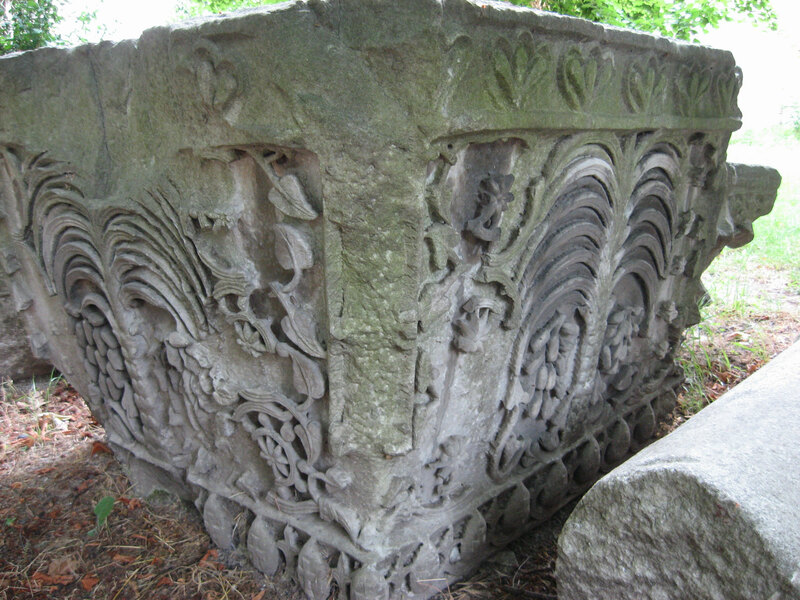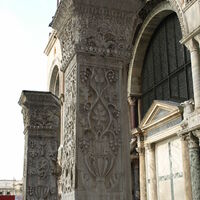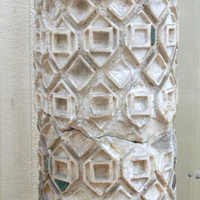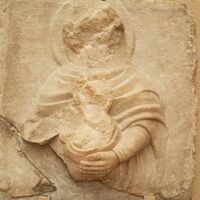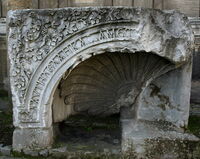Hagios Polyeuktos in Constantinople
Date:
ca. 525
Location or Findspot (Modern-Day Country):
Turkey
Description:
The basilica of Hagios (Saint) Polyeuktos was built in Constantinople in the mid-520s by the princess Anicia Juliana (462–527). She could trace her noble lineage back to Constantine, whose baptism was depicted in the narthex. An earlier church dedicated to the third-century martyr Polyeuktos had been built by her great-grandmother, the wife of Emperor Theodosios II, so Anicia Juliana was continuing a long family tradition of devotion and architectural patronage.
The measurements of the new church, in cubits rather than the usual Byzantine feet, imitated those of the Temple of Solomon in Jerusalem (as reported in the Bible, Ezek. 41). It was the largest church in the Byzantine capital before the construction of Hagia Sophia in 527. It was also the most opulently decorated: its ceiling was gilded, some of its columns were inlaid with colored glass and semiprecious stones, and many of the capitals were deeply carved with stylized plant forms that resemble Sasanian textiles and stucco work. The temple barrier was decorated with marble relief plaques (about 37 × 35 cm) showing frontal figures of Christ, the Theotokos, and apostles, early evidence for a decorated screen and for bust-length icons. All of the faces were chipped away during one of the periods of Byzantine iconoclasm.
The wide nave of Hagios Polyeuktos was bordered by semicircular recesses (exedrae) on both sides, and along the top of these, and on plaques at the entrance, was a long dedicatory epigram in Greek. This poem praises Anicia Juiana's fame and piety; she "surpassed the wisdom of the celebrated Solomon, raising a temple to receive God." (The inscription was recorded in a Byzantine collection and is partly preserved.) The upper parts of the exedrae were filled with carved peacocks whose bodies projected into the space of the church. Most of the remaining sculptural fragments are now in the Istanbul Archaeological Museum, but pieces were already reused as spolia in middle Byzantine Constantinople. Several pieces were taken to Venice and are now displayed outside the cathedral of San Marco.
There is no doubt that Justinian wanted to outdo Hagios Polyeuktos when he rebuilt Hagia Sophia a few years later. The latter church has survived, but Hagios Polyeuktos fell into disrepair and was despoiled and forgotten. It was rediscovered by chance and excavated in the 1960s.
The measurements of the new church, in cubits rather than the usual Byzantine feet, imitated those of the Temple of Solomon in Jerusalem (as reported in the Bible, Ezek. 41). It was the largest church in the Byzantine capital before the construction of Hagia Sophia in 527. It was also the most opulently decorated: its ceiling was gilded, some of its columns were inlaid with colored glass and semiprecious stones, and many of the capitals were deeply carved with stylized plant forms that resemble Sasanian textiles and stucco work. The temple barrier was decorated with marble relief plaques (about 37 × 35 cm) showing frontal figures of Christ, the Theotokos, and apostles, early evidence for a decorated screen and for bust-length icons. All of the faces were chipped away during one of the periods of Byzantine iconoclasm.
The wide nave of Hagios Polyeuktos was bordered by semicircular recesses (exedrae) on both sides, and along the top of these, and on plaques at the entrance, was a long dedicatory epigram in Greek. This poem praises Anicia Juiana's fame and piety; she "surpassed the wisdom of the celebrated Solomon, raising a temple to receive God." (The inscription was recorded in a Byzantine collection and is partly preserved.) The upper parts of the exedrae were filled with carved peacocks whose bodies projected into the space of the church. Most of the remaining sculptural fragments are now in the Istanbul Archaeological Museum, but pieces were already reused as spolia in middle Byzantine Constantinople. Several pieces were taken to Venice and are now displayed outside the cathedral of San Marco.
There is no doubt that Justinian wanted to outdo Hagios Polyeuktos when he rebuilt Hagia Sophia a few years later. The latter church has survived, but Hagios Polyeuktos fell into disrepair and was despoiled and forgotten. It was rediscovered by chance and excavated in the 1960s.
Relevant Textbook Chapter(s):
3
Repository and Online Resources:
• Read the H. Polyeuktos epigram here.
Image Credits:
Wikimedia Commons, Brad Hostetler, Domenico Nardone (wwwbisanzioit.blogspot.com)
